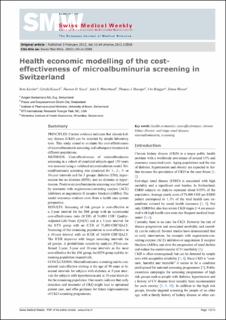Please use this identifier to cite or link to this item:
https://doi.org/10.21256/zhaw-4765Full metadata record
| DC Field | Value | Language |
|---|---|---|
| dc.contributor.author | Kessler, Reto | - |
| dc.contributor.author | Keusch, Gérard | - |
| dc.contributor.author | Szucs, Thomas | - |
| dc.contributor.author | Wittenborn, John | - |
| dc.contributor.author | Hoerger, Thomas | - |
| dc.contributor.author | Brügger, Urs | - |
| dc.contributor.author | Wieser, Simon | - |
| dc.date.accessioned | 2018-11-09T10:26:20Z | - |
| dc.date.available | 2018-11-09T10:26:20Z | - |
| dc.date.issued | 2012 | - |
| dc.identifier.issn | 1424-7860 | de_CH |
| dc.identifier.issn | 1424-3997 | de_CH |
| dc.identifier.issn | 0036-7672 | de_CH |
| dc.identifier.uri | https://digitalcollection.zhaw.ch/handle/11475/12712 | - |
| dc.description.abstract | Principles: Current evidence indicates that chronic kidney disease (CKD) can be detected by simple laboratory tests. This study aimed to evaluate the cost-effectiveness of microalbuminuria screening and subsequent treatment in different populations. Methods: Cost-effectiveness of microalbuminuria screening in a cohort of simulated subjects aged ≥50 years was assessed using a validated microsimulation model. Microalbuminuria screening was simulated for 1-, 2-, 5- or 10-year intervals and for 3 groups: diabetes (DM), hypertension but no diabetes (HTN), and no diabetes or hypertension. Positive microalbuminuria screening was followed by treatment with angiotensin-converting enzyme (ACE) inhibitors or angiotensin II receptor blockers (ARBs). The model outcomes evaluate costs from a health care system perspective. Results: Screening of risk groups is cost-effective at a 2-year interval for the DM group with an incremental cost-effectiveness ratio (ICER) of 54,000 CHF/ Quality Adjusted-Life-Years (QALY) and at a 5-year interval for the HTN group with an ICER of 33,000CHF/QALY . Screening of the remaining population is cost-effective at a 10-year interval with an ICER of 34,000 CHF/QALY . The ICER improves with longer screening intervals for all groups. A probabilistic sensitivity analysis (PSA) confirmed 2-year, 5-year and 10-year intervals as the most cost-effective for the DM group, the HTN group and the remaining population respectively. Conclusions: Microalbuminuria screening can be considered cost-effective starting at the age of 50 years at biannual intervals for subjects with diabetes, at 5-year intervals for subjects with hypertension and at10-year intervals for the remaining population. Our results indicate that early detection and treatment of CKD might lead to optimised patient care, and offer guidance for future implementation of CKD screening programmes. | de_CH |
| dc.language.iso | en | de_CH |
| dc.publisher | EMH Schweizerischer Ärzteverlag | de_CH |
| dc.relation.ispartof | Swiss Medical Weekly | de_CH |
| dc.rights | http://creativecommons.org/licenses/by-nc-nd/4.0/ | de_CH |
| dc.subject | Albuminuria | de_CH |
| dc.subject | Cost-benefit analysis | de_CH |
| dc.subject | Disease progression | de_CH |
| dc.subject | Follow-up study | de_CH |
| dc.subject | Mass screening | de_CH |
| dc.subject | Prevalence | de_CH |
| dc.subject | Retrospective study | de_CH |
| dc.subject | Economic models | de_CH |
| dc.subject.ddc | 362.1041: Gesundheitsökonomie | de_CH |
| dc.title | Health economic modelling of the cost-effectiveness of microalbuminuria screening in Switzerland | de_CH |
| dc.type | Beitrag in wissenschaftlicher Zeitschrift | de_CH |
| dcterms.type | Text | de_CH |
| zhaw.departement | School of Management and Law | de_CH |
| zhaw.organisationalunit | Winterthurer Institut für Gesundheitsökonomie (WIG) | de_CH |
| dc.identifier.doi | 10.21256/zhaw-4765 | - |
| dc.identifier.doi | 10.4414/smw.2012.13508 | de_CH |
| dc.identifier.pmid | 22307760 | de_CH |
| zhaw.funding.eu | No | de_CH |
| zhaw.originated.zhaw | Yes | de_CH |
| zhaw.pages.end | 13 | de_CH |
| zhaw.pages.start | 1 | de_CH |
| zhaw.publication.status | publishedVersion | de_CH |
| zhaw.volume | 142 | de_CH |
| zhaw.publication.review | Peer review (Publikation) | de_CH |
| Appears in collections: | Publikationen School of Management and Law | |
Files in This Item:
| File | Description | Size | Format | |
|---|---|---|---|---|
| Health economic modelling of the cost-effectiveness of microalbuminuria_2012_SC1.1.pdf | 858.18 kB | Adobe PDF |  View/Open |
Show simple item record
Kessler, R., Keusch, G., Szucs, T., Wittenborn, J., Hoerger, T., Brügger, U., & Wieser, S. (2012). Health economic modelling of the cost-effectiveness of microalbuminuria screening in Switzerland. Swiss Medical Weekly, 142, 1–13. https://doi.org/10.21256/zhaw-4765
Kessler, R. et al. (2012) ‘Health economic modelling of the cost-effectiveness of microalbuminuria screening in Switzerland’, Swiss Medical Weekly, 142, pp. 1–13. Available at: https://doi.org/10.21256/zhaw-4765.
R. Kessler et al., “Health economic modelling of the cost-effectiveness of microalbuminuria screening in Switzerland,” Swiss Medical Weekly, vol. 142, pp. 1–13, 2012, doi: 10.21256/zhaw-4765.
KESSLER, Reto, Gérard KEUSCH, Thomas SZUCS, John WITTENBORN, Thomas HOERGER, Urs BRÜGGER und Simon WIESER, 2012. Health economic modelling of the cost-effectiveness of microalbuminuria screening in Switzerland. Swiss Medical Weekly. 2012. Bd. 142, S. 1–13. DOI 10.21256/zhaw-4765
Kessler, Reto, Gérard Keusch, Thomas Szucs, John Wittenborn, Thomas Hoerger, Urs Brügger, and Simon Wieser. 2012. “Health Economic Modelling of the Cost-Effectiveness of Microalbuminuria Screening in Switzerland.” Swiss Medical Weekly 142: 1–13. https://doi.org/10.21256/zhaw-4765.
Kessler, Reto, et al. “Health Economic Modelling of the Cost-Effectiveness of Microalbuminuria Screening in Switzerland.” Swiss Medical Weekly, vol. 142, 2012, pp. 1–13, https://doi.org/10.21256/zhaw-4765.
Items in DSpace are protected by copyright, with all rights reserved, unless otherwise indicated.